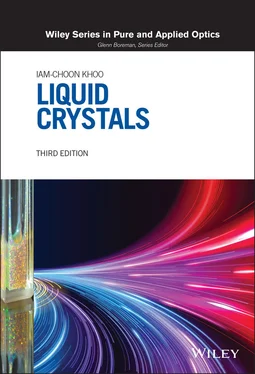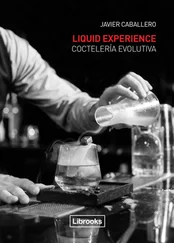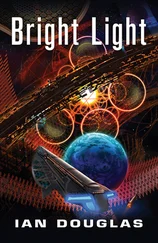Iam-Choon Khoo - Liquid Crystals
Здесь есть возможность читать онлайн «Iam-Choon Khoo - Liquid Crystals» — ознакомительный отрывок электронной книги совершенно бесплатно, а после прочтения отрывка купить полную версию. В некоторых случаях можно слушать аудио, скачать через торрент в формате fb2 и присутствует краткое содержание. Жанр: unrecognised, на английском языке. Описание произведения, (предисловие) а так же отзывы посетителей доступны на портале библиотеки ЛибКат.
- Название:Liquid Crystals
- Автор:
- Жанр:
- Год:неизвестен
- ISBN:нет данных
- Рейтинг книги:4 / 5. Голосов: 1
-
Избранное:Добавить в избранное
- Отзывы:
-
Ваша оценка:
- 80
- 1
- 2
- 3
- 4
- 5
Liquid Crystals: краткое содержание, описание и аннотация
Предлагаем к чтению аннотацию, описание, краткое содержание или предисловие (зависит от того, что написал сам автор книги «Liquid Crystals»). Если вы не нашли необходимую информацию о книге — напишите в комментариях, мы постараемся отыскать её.
Liquid Crystals,
Liquid Crystals
Liquid Crystals
Liquid Crystals — читать онлайн ознакомительный отрывок
Ниже представлен текст книги, разбитый по страницам. Система сохранения места последней прочитанной страницы, позволяет с удобством читать онлайн бесплатно книгу «Liquid Crystals», без необходимости каждый раз заново искать на чём Вы остановились. Поставьте закладку, и сможете в любой момент перейти на страницу, на которой закончили чтение.
Интервал:
Закладка:
(2.7) 
It is useful to note here that, in tensor form, ε αβcan be expressed as
(2.8) 
Note that this form shows that ε = ε ||for an optical field parallel to  and ε = ε ⊥for an optical field perpendicular to
and ε = ε ⊥for an optical field perpendicular to  .
.
Similarly, other parameters such as the magnetic ( χ m) and electric ( χ ) susceptibilities may be expressed as
(2.9a) 
and
(2.9b) 
respectively, in terms of their respective anisotropies Δ χ mand Δ χ .
In general, however, optical dielectric anisotropy and its dc or low‐frequency counterpart (the dielectric anisotropy) provide a less reliable measure of the order parameter because they involve electric fields. This is because of the so‐called local field effect: the effective electric field acting on a molecule is a superposition of the electric field from the externally applied source and the field created by the induced dipoles surrounding the molecules. For systems where the molecules are not correlated, the effective field can be fairly accurately approximated by some local field correction factor [3]; these correction factors are much less accurate in liquid crystalline systems. For a more reliable determination of the order parameter, one usually employs non‐electric‐field‐related parameters, such as the magnetic susceptibility anisotropy:
(2.10) 
2.1.3. Long‐ and Short‐range Order
The order parameter, defined by Eq. (2.2)and its variants such as Eqs. (2.4)and (2.8), is an average over the whole system and therefore provides a measure of the long‐range orientation order. The smaller the fluctuation of the molecular axis from the director axis orientation direction, the closer the magnitude of S is to unity. In a perfectly aligned liquid crystal, as in other crystalline materials, 〈cos 2 θ 〉 = 1 and S = 1; on the other hand, in a perfectly random system, such as ordinary liquids or the isotropic phase of liquid crystals, 〈cos 2 θ 〉 =  and S = 0.
and S = 0.
An important distinction between liquid crystals and ordinary anisotropic or isotropic liquids is that, in the isotropic phase, there could exist a so‐called short‐range order [1, 2]; that is, molecules within a short distance of one another are correlated by intermolecular interactions [4]. These molecular interactions may be viewed as remnants of those existing in the nematic phase. Clearly, the closer the isotropic liquid crystal is to the phase transition temperature, the more pronounced the short‐range order and its manifestations in many physical parameters will be. Short‐range order in the isotropic phase gives rise to interesting critical behavior in the response of the liquid crystals to externally applied fields (electric, magnetic, and optical) (see Section 2.3.2).
As pointed out at the beginning of this chapter, the physical and optical properties of liquid crystals may be roughly classified into two types: one pertaining to the ordered phase, characterized by long‐range order and crystalline‐like physical properties; the other pertaining to the so‐called disordered phase, where a short‐range order exists. All these order parameters show critical dependences as the temperature approaches the phase transition temperature T cfrom the respective directions.
2.2. MOLECULAR INTERACTIONS AND PHASE TRANSITIONS
In principle, if the electronic structure of a liquid crystal molecule is known, one can deduce the various thermodynamical properties. This is a monumental task in quantum statistical chemistry that has seldom, if ever, been attempted in a quantitative or conclusive way. There are some fairly reliable guidelines, usually obtained empirically, that relate molecular structures with the existence of the liquid crystal mesophases and, less reliably, the corresponding transition temperatures.
One simple observation is that to generate liquid crystals, one should use elongated molecules. This is best illustrated by the n CB homolog [5] ( n = 1, 2, 3,…). For n ≤ 4, the material does not exhibit a nematic phase. For n = 5–7, the material possesses a nematic range. For n > 8, smectic phases begin to appear.
Another reliable observation is that the nematic → isotropic phase transition temperature T cis a good indicator of the thermal stability of the nematic phase [6]; the higher the T c, the greater is the thermal stability of the nematic phase. In this respect, the types of chemical groups used as substituents in the terminal groups or side chain play a significant role – an increase in the polarizability of the substituent tends to be accompanied by an increase in T c.
Such molecular‐structure‐based approaches are clearly extremely complex and often tend to yield contradictory predictions because of the wide variation in the molecular electronic structures and intermolecular interactions present. In order to explain the phase transition and the behavior of the order parameter in the vicinity of the phase transition temperature, some simpler physical models have been employed [6]. For the nematic phase, a simple but quite successful approach was introduced by Maier and Saupe [7]. The liquid crystal molecules are treated as rigid rods, which are correlated (described by a long‐range order parameter) with one another by Coulomb interactions. For the isotropic phase, deGennes introduced a Landau type of phase transition theory [1–3], which is based on a short‐range order parameter.
The theoretical formalism for describing the nematic → isotropic phase transition and some of the results and consequences are given in the next section. This is followed by a summary of some of the basic concepts introduced for the isotropic phase.
2.3. MOLECULAR THEORIES AND RESULTS FOR THE LIQUID CRYSTALLINE PHASE
Among the various theories developed to describe the order parameter and phase transitions in the liquid crystalline phase, the most popular and successful one is the theory first advanced by Maier and Saupe and corroborated in studies by others [8]. In this formalism, Coulombic intermolecular dipole–dipole interactions are assumed. The interaction energy of a molecule with its surroundings is then shown to be of the form [6]:
Читать дальшеИнтервал:
Закладка:
Похожие книги на «Liquid Crystals»
Представляем Вашему вниманию похожие книги на «Liquid Crystals» списком для выбора. Мы отобрали схожую по названию и смыслу литературу в надежде предоставить читателям больше вариантов отыскать новые, интересные, ещё непрочитанные произведения.
Обсуждение, отзывы о книге «Liquid Crystals» и просто собственные мнения читателей. Оставьте ваши комментарии, напишите, что Вы думаете о произведении, его смысле или главных героях. Укажите что конкретно понравилось, а что нет, и почему Вы так считаете.












